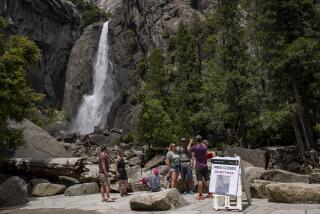Yosemite Critics Think Asphalt Is Poor Choice
- Share via
As work crews move ahead on a $12.5-million face-lift for Yosemite National Park’s most popular trail, there is much ado about asphalt.
For years, the well-traveled Yosemite Falls trail has been paved with blacktop, the better to survive under the weight of more than 1 million visitors who trudge up it in a typical year. The swarthy pavement conjures the image of an interstate rather than a natural path to one of nature’s scenic wonders.
Many park stewards anticipated that it would be replaced with a more aesthetically pleasing surface. But the park’s embracing of asphalt isn’t over.
In early fall, construction crews again will lay down battle-tested blacktop on one of the two quarter-mile routes to the falls’ misty base.
News of that decision was released by the park last year, but it is just now dribbling out to the public. There is grumbling.
Environmental advocates are asking why the park shrugged off more natural-looking pavements that are being rolled out in other parks around the West.
They say such surfaces, typically composed of polymers or resins that bind crushed rock, look more like a real dirt trail. They also don’t contain blacktop’s petrochemical compounds, which could pose environmental threats.
More than a few critics also have noted that continued use of asphalt runs counter to the spirit of the Yosemite Valley Plan, adopted with fanfare three years ago as a way to reduce urban influences in the majestic canyon.
“Yosemite is the crown jewel of the national park system, and as such it should be leading the way to do things in new and better ways,” said George Whitmore, the Sierra Club’s Yosemite committee chairman. “Why do we have to stick to something because it’s cheap and they’re comfortable with it? Yosemite should be thinking outside the box.”
Park officials, however, say the new kinds of pavement still haven’t passed muster.
The Yosemite Falls trail not only buzzes with foot traffic -- in winter months it must withstand the assault of snow-removal equipment. Finally, it must meet federal standards for people with disabilities.
Though the project is being financed almost completely by the nonprofit Yosemite Fund, the decision to go with blacktop was made by park officials.
“We like the idea of removing asphalt,” said Bob Hansen, president of the Yosemite Fund, which in the last 15 years has provided more than $20 million in cash grants for 150 projects in the park. “But we understand there are some areas where asphalt remains the material most appropriate for the conditions.”
To mute its coal-black appearance, the new blacktop will be dressed up with a topcoat of gray, sandy aggregate, Hansen said.
With weathering and a few layers of pine needles, he said, “you won’t have a surface that looks much like asphalt.”
Mike Reynolds, the park’s chief planner, said Yosemite’s trail maintenance experts knew of no alternative that they thought would survive the wear and tear of the hiking public and snow removal.
“Call us conservative, but we know what works in our high-traffic areas,” he said. “We relied on something tried and true.”
Such assessments irk promoters of the new types of pavement.
“It’s frustrating,” said Robert Randolph, president of Merced-based Soil Stabilization Products Inc., which has been trying to sell Yosemite on its natural resin-and-polymer pavements for years. “Asphalt is out of place in the park. It’s really wrong. The Yosemite Falls trail will look like a road straight out of Los Angeles.”
Randolph insisted that his product, which has been used on trails along the San Francisco shoreline and in Glacier National Park, can be formulated with powerful binders and carefully selected aggregates to withstand heavier rigors while offering a more natural appearance than asphalt.
“It can certainly survive anything they could dish out there,” he said.
Hansen, however, said officials were reluctant to experiment.
“You don’t want to make Yosemite Falls a proving ground,” he said. “If it doesn’t work, you don’t want a black eye in the most popular part of the park.”
The ambitious Yosemite Falls project will dramatically upgrade the gateway to the falls. Instead of a parking lot crowded with tourist buses and cars, the entry will include a picnic spot, redesigned restrooms and displays.
The trail will wind over heavily buttressed new bridges. More than 50 trees were cut to clear room, eliminate hazards and re-create views as they appeared during the early years of settlement.
The tree removal outraged several ecologists, who suggest that it went overboard. Whitmore said he was amazed to find one tree stump 5 feet across.
Bob Brower of the Wilderness Within Institute said he happened upon the logging operation in early April, and “it just blew my mind.” He later learned of the blacktop plans and was aghast.
“Other parks have a hint that this is not the way to go,” he said. “It’s just a shame. It’s like Yosemite has become Disneyland.”
More to Read
Sign up for Essential California
The most important California stories and recommendations in your inbox every morning.
You may occasionally receive promotional content from the Los Angeles Times.










